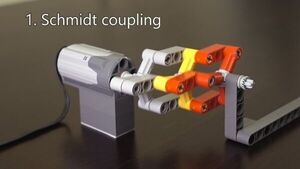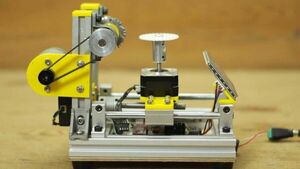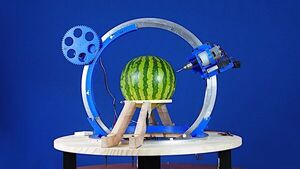2022-10-13 - Nº 389
Editorial
Esta é a Newsletter Nº 389 que se apresenta com o mesmo formato que as anteriores. Se gostar da Newsletter partilhe-a!
Todas as Newsletters encontram-se indexadas no link.
Esta Newsletter tem os seguintes tópicos:
Faz hoje anos que nascia, em 1776, o matemático e engenheiro inglê Peter Barlow. Ele inventou duas variedades de lentes telescópicas acromáticas (não-distorcedoras de cor). Em 1819, Barlow começou a trabalhar no problema do desvio das bússolas de navios causado pela presença de ferro no casco. Pelo seu método de correcção do desvio por justaposição da bússola com um pedaço de ferro com a forma adequada, foi-lhe atribuída a Medalha Copley. Em 1822, construiu um dispositivo que deve ser considerado um dos primeiros modelos de um motor eléctrico fornecido por corrente contínua. Trabalhou também no desenho de pontes, em particular trabalhando (1819-26) com Thomas Telford no desenho da ponte sobre o Estreito de Menai, a primeira grande ponte suspensa moderna. Barlow esteve activo durante o período da construção ferroviária na Grã-Bretanha.
Por fim, faz hoje anos que nascia, em 1932, o matemático norte-americano John G. Thompson. Ele recebeu a Medalha Fields em 1970 pelo seu trabalho em teoria de grupo, resolvendo (com Walter Feit) um dos seus problemas mais espinhosos, o chamado problema da "ordem estranha". (A teoria de grupo é um ramo da matemática que se concentra no estudo das simetrias - tais como as simetrias de uma figura geométrica, ou simetrias que surgem em soluções para equações algébricas). A prova de Thompson, com 253 páginas de equações, preencheu um número inteiro do Pacific Journal of Mathematics. Destaca-se como uma das mais longas e complexas da matemática. Thompson também colaborou na classificação dos grupos finitos simples, os blocos de construção de grupos mais gerais. A teoria dos grupos tem aplicações importantes em física, química e outros campos.
Em 1884, Greenwich foi adoptado como o meridiano universal. A pedido do Presidente dos EUA, 41 delegados de 25 nações reuniram-se em Washington, DC, para a Conferência Internacional do Meridiano. Na Conferência foram estabelecidos vários princípios importantes: um único meridiano mundial passando pelo principal Instrumento de Trânsito no Observatório de Greenwich; que toda a longitude seria calculada tanto a leste como a oeste a partir deste meridiano até 180°; um dia universal; e estudos do sistema decimal para a divisão do tempo e do espaço. A Resolução 2, que fixa o Meridiano em Greenwich foi aprovada 22-1 (San Domingo votou contra, França e Brasil abstiveram-se). Greenwich situa-se no rio Tamisa, a poucos quilómetros do centro de Londres.
Na Newsletter desta semana apresentamos diversas noticias, artigos científicos, projetos de maker e alguns vídeos interessantes.
 João Alves ([email protected])
João Alves ([email protected])
O conteúdo da Newsletter encontra-se sob a licença  Creative Commons Attribution-NonCommercial-ShareAlike 4.0 International License.
Creative Commons Attribution-NonCommercial-ShareAlike 4.0 International License.
Novidades da Semana
Outras Notícias

Star Duo Forms ‘Fingerprint’ in Space, NASA’s Webb Finds
"A new image shows at least 17 dust rings created by a rare type of star and its companion locked in a celestial dance. A new image from NASA’s James Webb Space Telescope reveals a remarkable cosmic sight: at least 17 concentric dust rings emanating from a pair of stars. Located just over 5,000 light-years from Earth, the duo is collectively known as Wolf-Rayet 140. Each ring was created when the two stars came close together and their stellar winds (streams of gas they blow into space) met, compressing the gas and forming dust. The stars’ orbits bring them together about once every eight years; like the growth of rings of a tree’s trunk, the dust loops mark the passage of time. “We’re looking at over a century of dust production from this system,” said Ryan Lau, an astronomer at NSF’s NOIRLab and lead author of a new study about the system, published today in the journal Nature Astronomy." [...]
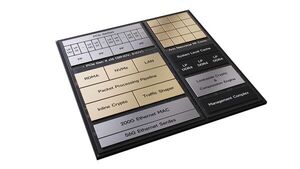
Boosting Performance with Programmable Processing
"Marking a significant milestone in delivering an end-to-end programmable platform that leverages the combined benefits of Intel’s hardware and software offerings, Google Cloud has announced the successful deployment of its new C3 machine series. The C3 machine series features 4th Gen Intel® Xeon® Scalable processors in private preview and debuts the Intel® infrastructure processing unit E2000, co-designed by Google and Intel. Through its unique architectural approach, C3 machine instances deliver strong performance gains of up to 20% over previous generation C2 instances, enabling high performance computing and data-intensive workloads. Google Cloud C3 machines also pave the way for a future where infrastructure processing units (IPUs) are integrated into data centers, accelerating cloud infrastructures and maximizing performance. “We are pleased to have codesigned the first ASIC infrastructure processing unit with Google Cloud, which has now launched in the new C3 machine series. A first of its kind in any public cloud, C3 VMs will run workloads on 4th Gen Intel Xeon Scalable processors while they free up programmable packetprocessing to the IPUs securely at line rates of 200 gigabits per second,” says Nick McKeown, Intel senior vice president, Intel Fellow and general manager of Network and Edge Group." [...]

Microsoft open sources its ‘farm of the future’ toolkit
"The gently rolling hills here in eastern Washington have long grown rich harvests of wheat, barley and lentils. Fifth-generation farmer Andrew Nelson is adding a new bumper crop to that bounty: Data. He gathers it from sensors in the soil, drones in the sky and satellites in space. They feed Nelson information about his farm at distinct points, every day, all year long — temperature variations, soil moisture and nutrient levels, plant health and more. Nelson in turn feeds that data into Project FarmVibes, a new suite of farm-focused technologies from Microsoft Research. Starting today, Microsoft will open source these tools so researchers and data scientists — and the rare farmer like Nelson, who is also a software engineer — can build upon them to turn agricultural data into action that can help boost yields and cut costs." [...]
Ciência e Tecnologia
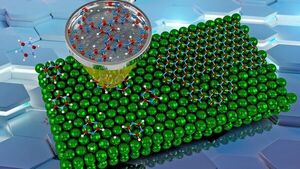
A new process to build 2D materials made possible by quantum calculations
"Quantum calculations performed by researchers from the University of Surrey have allowed scientists to discover new ‘phases’ of two-dimensional (2D) material that could be used to develop the next generation of fuel-cells devices. The calculations aided Graz University of Technology's research into the growth of one of the most promising 2D materials, hexagonal boron nitride (h-BN) - which has a honeycomb crystal structure almost identical to that of the most famous 2D material, graphene. Dr Anton Tamtögl, the project lead from Graz University of Technology, said: "The nanoporous phases discovered during our research are not of purely academic interest - they offer the potential for applications such as sensor materials, nanoreactors, and membranes. This work illustrates that fundamental physics and chemistry offer routes to truly relevant nanotechnology applications." Ultra-thin 2D materials are frequently grown by exposing a hot metal surface to a specific gas, which results in the gas decomposing on the metal and forming the desired 2D material. Due to the hot temperatures involved, it is difficult to monitor the growth of 2D materials during the several intermediate steps involved before the 2D material is completed." [...]
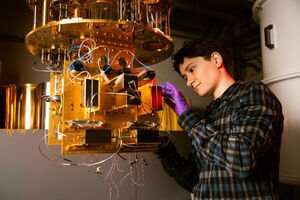
Making quantum computers more accurate
"PhD student Alex Greene studies superconducting quantum computing systems while rounding out their busy schedule with water sanitation projects. In Building 13 on MIT’s campus, there sits a half-a-million-dollar piece of equipment that looks like a long stretched-out chandelier, with a series of gold discs connected by thin silver pipes. The equipment, known as a dilution refrigerator, is a key player in PhD student Alex Greene’s research, as it houses all their experiments. “My life gets shaped around its rhythms,” they say. The first time Greene helped put new samples in the fridge, they were working with a postdoc at midnight on a Friday, blasting Danish screamo music. Ever since, the fridge has led them on both exciting and frustrating adventures throughout their PhD research on reducing errors in quantum computing systems." [...]
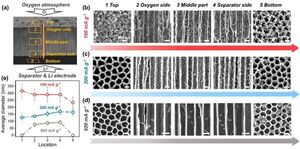
Researchers Unveil Mystery Inside Li- O2 Batteries
"With a high energy density, Li-O2 batteries have become a state-of-the-art battery technology. Inside the Li-O2 battery, the generation and disintegration of the discharged product solid lithium peroxide (Li2O2) have a significant effect on the battery’s performance. Previous researches shed little light on Li2O2 ‘s form and distribution inside, leaving questions regarding the trend and contributing factor of internal Li2O2 ‘s change in form and size unanswered. Recently, a team led by Prof. TAN Peng from the University of Science and Technology of China (USTC) of the Chinese Academy of Sciences designed a carbon-coated anodic aluminum oxide (C-AAO) air electrode with a highly-ordered, array-like structure. The team gained new insights into the sudden death and reaction routes of Li-O2 batteries. The work was published in Nano Letters." [...]

Tiny particles work together to do big things
"Simple microparticles can beat rhythmically together, generating an oscillating electrical current that could be used to power microrobotic devices. Taking advantage of a phenomenon known as emergent behavior in the microscale, MIT engineers have designed simple microparticles that can collectively generate complex behavior, much the same way that a colony of ants can dig tunnels or collect food. Working together, the microparticles can generate a beating clock that oscillates at a very low frequency. These oscillations can then be harnessed to power tiny robotic devices, the researchers showed. “In addition to being interesting from a physics point of view, this behavior can also be translated into an on-board oscillatory electrical signal, which can be very powerful in microrobotic autonomy. There are a lot of electrical components that require such an oscillatory input,” says Jingfan Yang, a recent MIT PhD recipient and one of the lead authors of the new study." [...]

Physicists use ‘electron correlations’ to control topological materials
"Strong electron interactions allow topological state to be switched on and off For the first time, U.S. and European physicists have found a way to switch the topological state of a quantum material on and off. Because they are extremely stable and have immutable features that cannot be erased or lost to quantum decoherence, topological states play an important role in materials research and quantum computing. In a study published in Nature Communications, researchers from Rice University, Austria’s Vienna University of Technology (TU Wien), Los Alamos National Laboratory and the Netherlands’ Radboud University described their method of using a magnetic field to activate and deactivate a topological state in a strongly correlated metal. “Topological properties are usually found in insulating materials with weak electron correlations,” said Rice study co-author Qimiao Si, a member of the Rice Quantum Initiative and director of the Rice Center for Quantum Materials (RCQM). “The material we study is metallic and is strongly correlated.” Strongly correlated quantum materials are those where the interactions of billions upon billions of electrons give rise to collective behaviors like unconventional superconductivity or electrons that behave as if they have more than 1,000 times their normal mass. Though physicists have studied topological materials for decades, they have only recently begun investigating topological metals that host strongly correlated interactions." [...]

With morphing limbs, a robot that travels by land and water
"Imagine being able to morph your legs into flippers before you jump in the water. Yale researchers have created a robot that accomplishes this feat through a process they dubbed “adaptive morphogenesis.” The project is described in the Oct. 12 edition of Nature and is featured on the issue’s cover. The robot, ART (Amphibious Robotic Turtle), takes inspiration from water and land turtles, a group whose fossil record spans over 110 million years. “Terrestrial and aquatic turtles share similar bodies, with four limbs and a shell, but have distinctive limb shapes and gaits adapted for their specific environment,” said Rebecca Kramer-Bottiglio, the John J. Lee Associate Professor of Mechanical Engineering & Materials Science and principal investigator of the study. “Sea turtles have elongated flippers for swimming, whereas land turtles and tortoises have rounded legs for load bearing while walking.” The robot features morphing limbs that can adapt their shape, stiffness, and behavior to the environment. The limbs use variable stiffness materials and artificial muscles to transform their shape when transitioning from one environment to another." [...]

Researchers develop automatic drawing machine for making paper-based metamaterials
"New approach creates metamaterials that are light, thin and flexible Researchers have developed an automatic drawing machine that uses pens and pencils to draw metamaterials onto paper. They demonstrated the new approach by using it to make three metamaterials that can be used to manipulate the microwave region of the electromagnetic spectrum. Metamaterials are artificially engineered composite materials that derive their properties from patterned microstructures, rather than the chemical composition of the materials themselves. The exact shape, geometry, size, orientation and arrangement of the structures can be used to manipulate electromagnetic waves in ways that aren’t possible with conventional materials. “Metamaterials, especially those used as absorbers, generally need to be thin, lightweight, wide and strong, but it isn’t easy to create thin and lightweight devices using traditional substrates,” said research team leader Junming Zhao from Nanjing University in China. “Using paper as the substrate can help meet these requirements while also lending itself to metasurfaces that conform to a surface or that are mechanically reconfigurable.” In the journal Optical Materials Express, the researchers describe their new technique, which uses a ballpoint pen with conductive ink to draw conductors and mechanical pencils to draw resistors and resistive films." [...]

New system designs nanomaterials that conduct heat in specific ways
"The technique could be used to fabricate computer chips that won’t get too hot while operating, or materials that can convert waste heat to energy. Computer chips are packed with billions of microscopic transistors that enable powerful computation, but also generate a great deal of heat. A buildup of heat can slow a computer processor and make it less efficient and reliable. Engineers employ heat sinks to keep chips cool, sometimes along with fans or liquid cooling systems; however, these methods often require a lot of energy to operate. Researchers at MIT have taken a different approach. They developed an algorithm and software system that can automatically design a nanoscale material that can conduct heat in a specific manner, such as channeling heat in only one direction." [...]
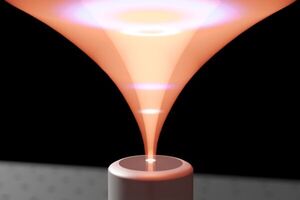
Optical foundations illuminated by quantum light
"Despite being considered well established, the physics of optical waves have some fundamental aspects, which are still under debate. One of these effects, the anomalous behaviour of focused light fields, has now been investigated in a new light, a quantum light. Researchers from Tampere University, Finland, have shown that quantum light with a well-defined photon number behaves differently to standard focused laser beams. This finding both deepens understanding of the phenomena and enables super-sensitive distance measurements. Optics, the study of light, is one of the oldest fields in physics and has never ceased to surprise researchers. Although the classical description of light as a wave phenomenon is rarely questioned, the physical origins of some optical effects are." [...]
Research Aims to Help Semiconductor Industry Make Computing Less of an Energy Hog
"The amount of energy used for computing is climbing at an exponential rate. Business intelligence and consulting firm ENERDATA reports that information, communication and technology accounts for 5% to 9% of total electricity consumption worldwide. If growth continues unabated, computing could demand up to 20% of the world’s power generation by 2030. With power grids already under strain from weather-related events and the economy transitioning from fossil fuel to renewables, engineers desperately need to flatten computing’s energy demand curve. Members of Jon Ihlefeld’s MULTIFUNCTIONAL THIN FILM GROUP are doing their part. They are investigating a material system that will allow the semiconductor industry to co-locate computation and memory on a single chip." [...]

New measurements quantifying qudits provide glimpse of quantum future
"Using existing experimental and computational resources, a multi-institutional team has developed an effective method for measuring high-dimensional qudits encoded in quantum frequency combs, which are a type of photon source, on a single optical chip. Although the word “qudit” might look like a typo, this lesser-known cousin of the qubit, or quantum bit, can carry more information and is more resistant to noise — both of which are key qualities needed to improve the performance of quantum networks, quantum key distribution systems and, eventually, the quantum internet. Classical computer bits categorize data as ones or zeroes, whereas qubits can hold values of one, zero or both — simultaneously — owing to superposition, which is a phenomenon that allows multiple quantum states to exist at the same time. The “d” in qudit stands for the number of different levels or values that can be encoded on a photon. Traditional qubits have two levels, but adding more levels transforms them into qudits. Recently, researchers from the U.S. Department of Energy’s Oak Ridge National Laboratory, Purdue University and the Swiss Federal Institute of Technology Lausanne, or EPFL, fully characterized an entangled pair of eight-level qudits, which formed a 64-dimensional quantum space — quadrupling the previous record for discrete frequency modes." [...]

ESnet Launches Next-Generation Network to Enhance Collaborative Science
"ESnet6 provides over 46 Terabits per second of bandwidth and intelligent network services to support unique data-intensive needs of scientific research Today, the Energy Sciences Network (ESnet) formally unveiled ESnet6, the newest generation of the U.S. Department of Energy’s (DOE’s) high-performance network dedicated to science. The hybrid in person and virtual event was held at Lawrence Berkeley National Laboratory (Berkeley Lab) and live-streamed on streaming.lbl.gov. “ESnet6 represents a transformational change in the way networks are built for research, with improved capacity, resiliency, and flexibility,” said ESnet Executive Director Inder Monga. “Together, these new capabilities make it faster, easier, and more efficient for scientists around the world to conduct and collaborate on ground-breaking research.” For more than 35 years, ESnet – headquartered at Berkeley Lab – has served as the “data circulatory system” for the DOE, connecting all of its national laboratories, tens of thousands of DOE-funded researchers, and DOE’s premier scientific instruments and supercomputing centers. This interconnected system enables data to move quickly between sites and collaborators, accelerating time to discovery. ESnet6 takes the network’s capabilities to the next level." [...]

Stanford exoskeleton walks out into the real world
"After years of careful development, engineers have created a boot-like exoskeleton that increases walking speed and reduces effort outside of the lab. For years, the Stanford Biomechatronics Laboratory has captured imaginations with their exoskeleton emulators – lab-based robotic devices that help wearers walk and run faster, with less effort. Now, these researchers will turn heads out in the “wild” with their first untethered exoskeleton, featured in a paper published Oct. 12 in Nature. “This exoskeleton personalizes assistance as people walk normally through the real world,” said Steve Collins, associate professor of mechanical engineering who leads the Stanford Biomechatronics Laboratory. “And it resulted in exceptional improvements in walking speed and energy economy.” This “robotic boot” has a motor that works with calf muscles to give the wearer an extra push with every step. But, unlike other exoskeletons out there, this push is personalized thanks to a machine-learning-based model that was trained through years of work using emulators." [...]
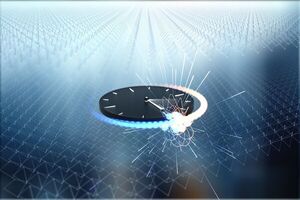
Seeing electron movement at fastest speed ever could help unlock next-level quantum computing
"New technique could enable processing speeds a million to a billion times faster than today's computers and spur progress in many-body physics The key to maximizing traditional or quantum computing speeds lies in our ability to understand how electrons behave in solids, and a collaboration between the University of Michigan and the University of Regensburg captured electron movement in attoseconds—the fastest speed yet. Seeing electrons move in increments of one quintillionth of a second could help push processing speeds up to a billion times faster than what is currently possible. In addition, the research offers a “game-changing” tool for the study of many-body physics. “Your current computer’s processor operates in gigahertz, that’s one billionth of a second per operation,” said Mackillo Kira, U-M professor of electrical engineering and computer science, who led the theoretical aspects of the study published in Nature. “In quantum computing, that’s extremely slow because electrons within a computer chip collide trillions of times a second and each collision terminates the quantum computing cycle. “What we’ve needed, in order to push performance forward, are snapshots of that electron movement that are a billion times faster." [...]
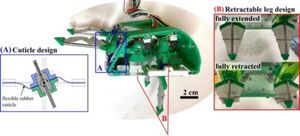
Digging deep
"Inspired by nature, the burrowing mole crab robot is a feat of engineering with real-world applications The unassuming Pacific mole crab, Emerita analoga, is about to make some waves. UC Berkeley researchers have debuted a unique robot inspired by this burrowing crustacean that may someday help evaluate the soil of agricultural sites, collect marine data and study soil and rock conditions at construction sites. In a study published today in Frontiers in Robotics & AI, Hannah Stuart, assistant professor of mechanical engineering, and her team demonstrated one of the first legged robots that can self-burrow vertically. This digging robot, called EMBUR (EMerita BUrrowing Robot), uses a novel leg design to achieve downward motion that emulates the way Pacific mole crabs bury themselves in beach sand. Mole crabs make burrowing look easy, but, according to Laura Treers, the study’s lead author and a Ph.D. student in mechanical engineering in Stuart’s Embodied Dexterity research group, it is difficult to move downward through granular media, like sand and soil. The deeper an animal digs, the harder the grains push back, impeding excavation." [...]
Modelos 3D
Com a disponibilidade de ferramentas que permitem dar azo a nossa imaginação na criação de peças 3D e espaços como o thingiverse para as publicar, esta rubrica apresenta alguns modelos selecionados que poderão ser úteis.
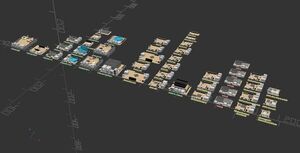
SBC Model Framework
"This project is a lightweight and dynamic framework for the generation of SBC and micro-controller models written in OpenSCAD. Current SBC: 47 represented by 43 models. Some SBC in SBC Model Framework have not been validated and may produce one or more aspects of the SBC incorrectly. GREEN = verified to be correct using SBC Case Builder. YELLOW = unverified, mostlikely usable and/or missing minor information. ORANGE = unverified, may be usable but missing component data." [...]
Projetos Maker
Diversos Projetos interessantes.

MacTempTosh Version 2 With ADT7420 Sensor
"Hello and welcome back. So this is MacTempTosh version 2, a mini Macintosh 128K Look-like Temperature Meter that displays the current room temperature using the ADT7420-based Seeed Grove Module. Its previous version featured a similar setup but the temperature sensor was different so I swapped out the temperature sensor and made a few minor changes to the body and made Version 2. This Instructables is about how easy it is to use the ADT7420 Sensor and how to prepare a simple temperature meter with it so let's get started. Supplies Following are the materials used in this built- - Seeed Grove Module ADT7420 Temperature Sensor - ESP32 Generic Board - Arduino Nano - Breadboard - SSD1306 OLED Screen - 3D Printed parts - jumper wires - IP5303 Boost Module - Lithium-ion Cell" [...]

Designing and Building a PIC32 Video Game
"Two students at Cornell University have developed a video game based on a PIC32 Microcontroller using a new version of the boids algorithm. We created a multiplayer video game that runs on a PIC32 microcontroller (Figure 1). Our game simulates predator-prey interactions in nature. Through distinct game modes, players can experience what it is like to be both the hunter and the hunted. The player uses a joystick to control a Salmon or a Tuna, earning points by eating minnows. The game is lost when time runs out or the player is eaten by the Shark." [...]
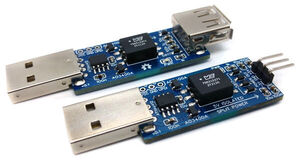
USB Power Isolator
"For some applications, a galvanically isolated power supply is required to avoid ground loops or short circuits, or simply for mutual protection. The USB Power Isolator offers the possibility of a simple isolation (2.5kV) of the 5V rail of a USB power adapter with an unregulated output and a maximum continuous current of 1A. The USB Power Isolator isolates the power rail only, for full isolation including data lines take a look at the ADuM3160 USB Isolator. Working Principle Using its powerful Timer/Counter D (TCD), the ATtiny212/412 controls a center-tapped transformer utilizing the push-pull topology by providing complementary output signals with intermediate dead times (break-before-make time) to drive the two ground-referenced N-channel MOSFETs connected to the transformer's outer taps and alternately turn them on and off. The implemented switching frequency of 400kHz is specially tailored to the Würth Elektronik 750315371 transformer, but other frequencies and features like spread spectrum clocking can be implemented in software if required. There are actually special ICs to drive push-pull transformers, in the case of the WE750315371 this is for example the SN6505B." [...]
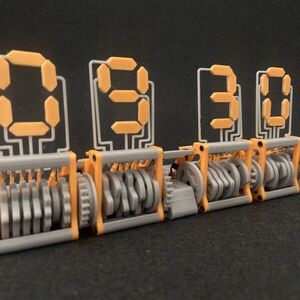
Eptaora
"7 segment clock This project was inspired by another similar project that I saw a few years back. I mostly rebuilt it completely and challenged myself to print it as small as possible on a standard 3d printer using a standard nozzle. The size was determined by the smallest screw hole that was possible. The clock consists of 4 modules which work in a pair to display the time. The mechanism is quite simple using a set of cams and followers. The stepper motor turns one module and the second one is driven by a carry over mechanism." [...]
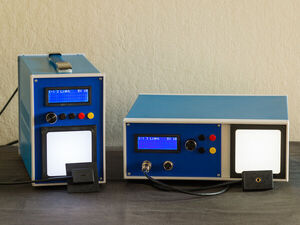
Film Camera Tester
"The idea of using Arduino for measuring camera shutter timings is not new. What I've tried to do here, is to make a modular system with a set of features normally offered in professional testers, at the same time to keep its design simple and available to reproduce using off-the-shelf components. Usually, time counting and/or light integration methods are used to test cameras. For the time counting method, you need a light sensor, a time counter, and a simple light source. With such setup you can measure exposure time(s) provided by a shutter, curtains travel speed of a focal plane shutter, flash sync contact delays, etc. For the second method, you'll need a photosensor able to measure the amount of light and a calibrated light source." [...]

Talking Bingo computer
"This is a talking Bingo computer made with a Arduino Nano Every. It can be set for 75, 90 and more.. Has 3 screens. This is a talking Bingo computer. It tells the choosen number and display is on a big 7 segment screen and on a 90 number screen. You can see it on a small 7 segment display direct. With a rotary encoder you can move over the bingo numbers." [...]
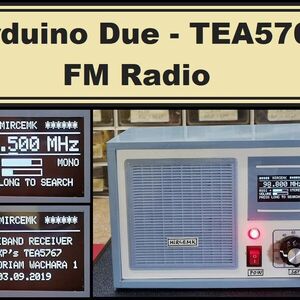
DIY Arduino Due TEA5767 FM Radio
"How to make a small FM Radio with oled display which all functions are controlled by a single rotary encoder. Homemade Arduino Due radio with TEA5767 FM module This time I will show you how to make a small FM Radio with oled display which all functions are controlled by a single rotary encoder. So far I have made several FM radios, but this is my first project with an Arduino Due board. The Arduino Due is a microcontroller board based on the Atmel ARM Cortex-M3 CPU. It is the first Arduino board based on a 32-bit ARM core microcontroller. It has 54 digital input/output pins of which 12 can be used as PWM outputs, 12 analog inputs, 4 UARTs , a 84 MHz clock, an USB OTG capable connection, 2 (digital to analog), 2 TWI, a power jack, an SPI header, a reset button and an erase button." [...]

Radio Frequency power detector "sniffer")
"A wide range RF detector 50-3000Mhz with battery charger, ATtiny micro controller and SMD. The RF detector can be used as linear instrument monitor or as threshold/comparator alarm, it depends from DipSwitch1-1 setting: On=instrument, Off=comparator. The threshold level comes from 10K trimmer you may set as you like. In instrument mode both buzzer and top panel RGB LED change their level (sound & light) depending of the detected RF power level. DipSwitch1-2 setting: On=buzzer on, Off=buzzer off. By the way of DipSwitch2-1 and DipSwitch2-2 you may change the colour of the top panel RGB LED: 00=off 01=red 10=green 11=blue." [...]
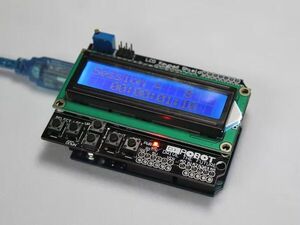
Power Time Logger for Arduino UNO
"Records each time a USB port is powered on/off and logs the data for up to 24 hours. Power Time Logger records each time a USB port is powered on/off. Total recording time is 24 hours. Press the SELECT button to switch between total on/off and total time. Press the LEFT button to reset the program. Use this project to log usage times for any device that has an on/off USB port (wifi router, 3D printer, computer, etc.)." [...]
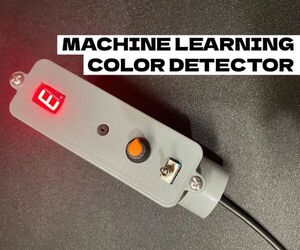
Machine Learning Powered Color Detector (On Any Microcontroller!)
"Today I'll be showing you how to create a color detector using cheap parts you (probably) already have! This project would be useful for automation in warehouses and factories where you simply need to know if something is red, yellow, or some other color. As you've read from the title, we use machine learning to categorize what color the detector is looking at... but don't worry! We aren't using special boards, TensorFlow, or anything complicated. This project can be done with any microcontroller, and the machine learning part is only one function! You'll need these to make your own Color Detector - 1" Conduit Body from a hardware store - Arduino Nano (or any other microcontroller) - A phototransistor - Red, green, blue, and yellow LEDs - Seven Segment Display - A Button - Linear Potentiometer (Any resistance) - Toggle Switch (Make sure it's durable!" [...]
Spotify & NeoPixel Controller
"Intuitive control of Spotify using Arduino MKR IoT Carrier This need arose from the fact that within the Electronic Cat’s office there is a sound system where music is played, however only one device has control of the music, it also has an ambient lighting system using NeoPixel strips that were in disuse. The objective of the project was to create an intuitive system with which any person could intuitively control the music for everyone without the need to have access to another person's device, since nowadays every device contains sensitive information, in addition to making use of the ambient lighting that was in place to illuminate a shelf of products. The development of the project was based on the existing project created by a user of the Arduino community, Opla Spotify Controller, with which you can control the playback of music from a Spotify account through an API. From this project, we were making modifications and adding features to meet the objectives set at the beginning. The main resource for the development is the Arduino products, both the Arduino MKR IoT Carrier and the Arduino MKR WiFi 1010 board since the original project on which this is based makes use of this hardware and it is necessary to have hardware with WiFi connectivity capabilities, with these two products could have an intuitive interface and hardware for the user showing information of the activity about the music playback through Spotify. And all powered by the tiny but very powerful CatSink!" [...]
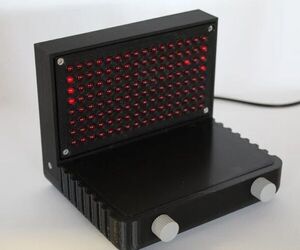
LED Pong
"Pong was the start of a new ear. Though it was not the first video game ever invented, it is certainly the one that is credited with starting the video game craze. Its first appearance at a consumer level was with the release of the Magnavox Odyssey in 1972. The Odyssey shipped 12 different games on the console, but Table Tennis (pong) was by far the most popular of them. Later, the concept of video table tennis was refined by Atari into the version we all know and love and given it's new name pong. I have had a slight obsession with this game for a few years." [...]
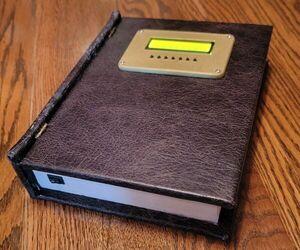
Arduino Riddle Word Book Lock Box
"This is a riddle word book lock box powered by an Arduino Nano. Designed for an escape room, the book lock box will automatically unlock when the gamer enters the correct answer to the riddle. The book box itself was purchased from Michael's craft store and then modified to hold the Arduino components and locking mechanism. Additionally the book lock box was covered with a leather-looking material on the outside, and black vinyl on the inside. To build this you will need a 3D printer (for the LCD faceplate and locking mechanism) as well as the ability to do simple soldering. Supplies Main components - Michael's Craft Store book box - Arduino Nano - I2C 1602 Serial LCD (16 x 2) - SG90 Micro Servo 9g - 2 AA battery cases - 1 rocker switch - 9 6x6x9mm micro button switches - 2.54mm 10-pin female-to-female flat ribbon data connector, dual row - 2 2.54mm DC3-10 pin male shrouded box headers - 1 2.54mm JST-XH wired 2 pin male connector with female header - 1 2.54mm JST-XH wired 3 pin male connector with female header - 1 2.54mm 3 pin right angle header (optional) - 2 2.54 mm JST-XH wired 4 pin male connector with female header - 1 2.54mm 4 pin right angle header (optional) - 1 2.54mm 40 pin single row header - 3/4" x 3/4" x 1" aluminum angle - 1/4" x 1/4" x 9 3/4" square wood dowel - (optional) - required if the material used to cover the book is thick - used to raise the hinge screw holes Screws - 2 M2 x 12 screws with nuts - 4 M2 x 4 screws - 4 M3 x 16 screws with nuts - 4 M3 x 4 screws - 4 M3 Nylon standoffs - 4 battery holder wood screws (approx 5.1mm head x 9.5mm length) - 4 book latch wood screws (approx 4mm head x 6mm length) - 2 large servo mount wood screws (approx 7.5mm head x 19.7mm length) - 2 small servo mount wood screws (approx 5mm head x 12mm length) Book Covering - 12" x 12" outer fabric covering - 8 1/2" x 11 1/4" outer fabric covering - 10 1/2" x 12 1/2" inner lining covering - 9 1/4" x 6 3/4" inner lining covering" [...]
WIFI Control Car Arduino Concept | Internet of Things
"We built the car employing a variety of transmission methods. But what about a car that can be controlled over WIFI. WIFI Control Car – Arduino Concept “We built the car employing a variety of transmission methods. But what about a car that can be controlled over WIFI.” WIFI is the most promising technology right now, and developers are always working to improve it. This technology is prevalent today and will be for many years to come. WIFI with low power consumption has also been developed." [...]

Analumi_Clock V3
"Part of the process of making the Analumi-Clock was experimenting with different display mediums. In this version the display medium was a 3D printed photo luminescent transluscent disc. The intention was this would to be lit from the back using the same UV LED's In order to retain compatibility with the previous version the display disc would be the same size as a CD and be a push fit on to the motor spindle. This meant that the disc and the axle could be printed as one complete unit. Only one photo luminescent filament was evaluated and this was compared to the photo luminescent paper, regarding initial intensity, clarity and light decay. This version used the same hardware and software from the previous Analumi-Clock with very minor changes." [...]

Autopilot for sailing boats (NEW! - Version 2)
"Let's take a break during navigation while Autopilot follows the route, control it with remote control. Project contains many improvements! The new autopilot: Hello! Coming from the experience of the first version here it is the second one. The circuit is much more robust and solid (the Uno wafer style was a nightmare...), I added an ADC controller for current absorption calculation, there are two separated voltage regulators for 5V: one for the circuit and a bigger one for the stepper motor. I introduced PID algorithm (Progressive, Integrative, Derivative) so we can modify the behaviour, the responsiveness, of the autopilot, smooth or aggressive." [...]

Arduino Synthesizer
"This is a multi-voice programmable synthesizer built from an Arduino Pro Micro. The voices come from Arduino output pins programmed to produce square waves and pulse waves. One of these pins is used to subject an external audio input to unique distortions. All the voices are combined with mixer and modulation circuitry creating a wide variety of crazy timbres. USB MIDI Control over the Synthesizer can be set up using the USBMIDI.h Library. Supplies - Arduino Pro Micro from Sparkfun Electronics (5volt version)." [...]

Lowcost Wireless Rocket Launcher
"This project allows to launch gunpowder rockets safely and with a lot of fun. (coutdown display with access code and sound). I enjoy launching gun powder rockets with my son Thomas. This project allows to make automatic launches from a safe distance with lots of fun. Caution: While the circuits are powered on, always stay at a safe distance from the rocket! " [...]
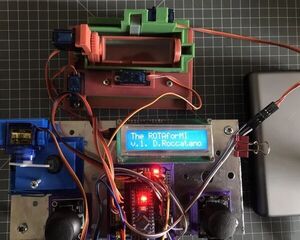
The ROTAforMI: a RObotic TAble for Microscopy
"The ROTAforMI is a versatile robotic device for controlling the position and orientation of a microscope slide using four degrees of freedom. This prototype is a complementary development of the idea behind the Roto-microscope project. It was inspired by related projects of servo motors-controlled micromanipulators and 3D micro scanners. The device is entirely 3D printed and is actioned by four small servos controlled by one Arduino Nano microcontroller. The device can be controlled manually using two micro joysticks (and possibly also automatically via a programmed sequence of movements). In addition, a Bluetooth remote can take snapshots with a smartphone's camera." [...]

Spooky Scary Skeleton
"Build your own cute Spooky Scary Skeleton Robot for Halloween - Using a Raspberry Pi Pico/Pico W, HC-SR04 Ultrasonic Range finder, and an SG90 Servo The project works in a relatively simple fashion: essentially, a Raspberry Pi Pico is charged with reading an HC-SR04 ultrasonic rangefinder. It’s all wrapped up in a 3D-printed skull-like housing. When the skeleton detects someone or something close in front, the Pi triggers a small servo hooked up to a 3D-printed gear. This interfaces with a pair of racks which drive the skull’s eyebrows up and down, and opens and shuts its jaw. Of course, there are some major anatomical problems here. Skulls don’t have eyebrows; that’s just not possible." [...]

JägerMachine
"An IoT shot pouring machine powered by a Raspberry Pi The JägerMachine is an IoT shot pouring machine powered by a Raspberry Pi 3B+. It features a full GUI that allows the user to configure the device, pour a shot, and also check previous messages sent to the machine. Once paired with it's own GMail account, the JägerMachine waits for emails containing a secret user defined subject line and a custom message that gets displayed on the screen. Once an email is received a shot is poured :) Initially this project started as a gift for a friend. We always give each other Jagermeister related gifts as an inside joke, so I figured this would be PERFECT. It started out as a pretty bland render I threw together on Fusion 360 as seen below and slowly started getting more and more complicated." [...]
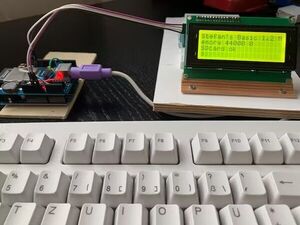
The 10 Euro IoT Computer With ESP 8266
"A little computer based on a datalogger shield, an ESP8266 dev board and a few other components running an IoT capable BASIC interpreter. The Idea This project is about building a small IoT computer running with BASIC with low cost components. There is a lot of powerful hardware on the market that can be used for it. Integrating them properly can get a lot of compute power for almost no money. The computer presented here serves in my home as an MQTT display station. It is connected to Wifi, reads messages from an MQTT broker, displays and records them." [...]
Secção Videos
Videos interessantes.
That's all Folks!




